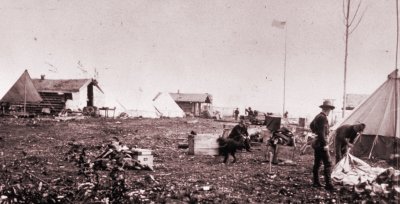
|
|
|
|
History of Eagle CityEagle City got its start when, in 1897, disgruntled gold prospectors who had been unsuccessful in the Klondike were joined by a group of business people.Together, they decided to start their own city on the other side of the International border. They located a good spot twelve river miles beyond the Canadian border, and they chose the name "Eagle City" for the eagles nesting on the bluff.They offered the 300-400 lots they had staked to anyone willing to buy. A $5 recorder fee gave the new owner 30 days to brush the adjoining streets and a year to erect a building. Most of the 200 cabins built during its first year were crude one-room log cabins with dirt or pole roofs. Commerce Begins By
1898, the
population had reached 700. The commercial center was a row of log
cabins which included several saloons, gambling halls, restaurants and four
large commercial companies. Above, B Street in 1899. Fort EgbertThe arrival of the U. S. Army in 1899 gave a needed economic boost to Eagle City. They built Fort Egbert adjacent to the city. The military's duty was to provide
law and order, establish roads and communications and to assist the
indigent miners. One of their major accomplishments was
building the WAMCATS (Washington -Alaska Military cable and telegraph
system.) provide
law and order, establish roads and communications and to assist the
indigent miners. One of their major accomplishments was
building the WAMCATS (Washington -Alaska Military cable and telegraph
system.)Above, Major Richardson's tent camp at Fort Egbert. Early Mining
Above, miners using a rocker. Eagle's Claim to Fame
The
first Federal Court in Alaska's interior was established here by Judge James
Above, Courthouse & Jail in Eagle City. Government of Eagle
Above, Eagle City Hall, built in 1901. ProgressBy 1903 the telegraph line from Eagle City to Valdez was completed, becoming part of the 1,497 mile WAMCATS (see above). Lt. William Mitchell, with his headquarters at Fort Egbert, Eagle City from 1901-1903, was in charge of the construction of much of the line. The U.S. Senate Committee on Territories visited Eagle in 1903 and strongly supported the building of a railroad between Valdez and Eagle along the government mail trail and telegraph line, and when they returned to Washington D.C., funds were appropriated. Roald Amundsen
Above, polar explorer, Roald Amundsen The 1902 Gold Strike in the Tanana Valley soon made a tremendous difference. By 1904, Judge Wickersham had moved his court's headquarters to Fairbanks. The wireless replacing the need for the telegraph line led to the U. S. Army Infantry abandoning Fort Egbert in 1911. Because many of the residents were civilian employees at the fort, the population of Eagle City dropped dramatically. The remaining residents stayed, keeping Eagle City from becoming just another gold rush ghost town as did many of the Alaskan communities established at that time. Many of the original prospectors continued to work their claims, remaining for the rest of their lives. Though the miners weren't getting rich, they enjoyed their independent life. Other residents worked as trappers, hunters, miners, mail carriers, road house operators, peddlers, teachers and federal employees. Present Day Eagle CityNew life came to the area with the opening of the Taylor Highway into Eagle City in 1953. The population rose to 150-200. Today Eagle has a motel, a restaurant, a campground, B&B's, hook-ups, grocery stores, garages, communication services, a gravel airfield, river trips, a daily tour boat to Dawson, and canoe rentals. There is an all volunteer public library and an museum housed in five historic buildings. The community even boasts a school with grades K-12. Eagle City was placed on the National Register of Historic Places in 1970, becoming a National Landmark in 1975. This small rural community continues to place a high priority on preserving its local history and historical buildings. |
| ||||||||